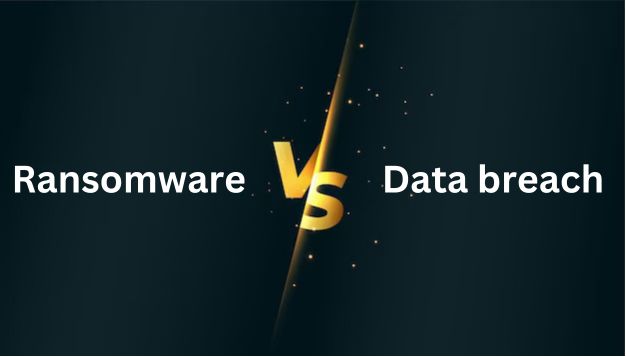In the ever-evolving landscape of cybersecurity, two terms that often strike fear into the hearts of individuals and organizations alike are “ransomware” and “data breach.” Both phenomena represent significant threats to the confidentiality, integrity, and availability of sensitive information.
In this comprehensive exploration, we will delve into the nuances of ransomware vs data breach, dissecting their characteristics, impact, and preventive measures.
Contents
I. Ransomware: A Stealthy Digital Extortionist
A. Definition and Operation
Ransomware is a type of malicious software designed to block access to a computer system or files until a sum of money, or ransom, is paid. It operates by encrypting the victim’s data, rendering it inaccessible, and then demanding payment for its release. Ransomware attacks can target individuals, businesses, or even entire government systems.
B. Evolution and Tactics
Ransomware has evolved over the years, with attackers becoming more sophisticated in their tactics. Initially distributed through phishing emails and malicious links, modern ransomware exploits vulnerabilities in software and leverages advanced social engineering techniques. Some variants, such as Ryuk and Maze, go beyond encryption and threaten to expose sensitive data if the ransom is not paid.
C. Impact
The impact of a successful ransomware attack can be devastating. Beyond the immediate financial loss from paying the ransom, organizations may face reputational damage, legal consequences, and operational disruptions. The loss of critical data can cripple businesses and erode the trust of customers and stakeholders.
II. Data Breach: Breaching the Fortress of Confidentiality
A. Definition and Causes
A data breach occurs when unauthorized individuals gain access to sensitive information, often with the intent to use, sell, or disclose it for malicious purposes. Breaches can result from cyberattacks, human error, or internal threats. Common types of data exposed in breaches include personal information, financial data, and intellectual property.
B. Entry Points and Vectors
Data breaches can occur through various entry points, including network vulnerabilities, insecure applications, or compromised credentials. Attack vectors range from hacking and malware to physical theft and insider threats. The interconnected nature of digital systems makes it challenging to secure every potential entry point, heightening the risk of a breach.
C. Ramifications
The ramifications of a data breach extend far beyond the initial compromise. Apart from financial losses, organizations may incur legal penalties, compliance violations, and damage to their brand reputation. The stolen data can be misused for identity theft, fraud, or even sold on the dark web, amplifying the long-term consequences for affected individuals.
III. Differentiating Ransomware vs Data Breach
While ransomware and data breaches both involve unauthorized access to sensitive information, they differ fundamentally in their objectives and methods. Ransomware seeks financial gain through extortion, whereas data breaches focus on acquiring information for various malicious purposes.
A. Motivation
Ransomware attackers are primarily motivated by monetary gain. Their goal is to force victims into paying a ransom to regain access to their data. On the other hand, data breaches can be motivated by financial gain, corporate espionage, activism, or even state-sponsored cyber-espionage.
B. Extortion vs Exfiltration
Ransomware encrypts data and demands payment for its release, employing extortion as the primary tactic. In contrast, data breaches involve the unauthorized exfiltration of sensitive information, with the threat of exposure or misuse acting as leverage.
C. Notification and Communication
Ransomware attacks often come with explicit ransom notes, providing instructions on how victims can pay to recover their data. In contrast, data breaches may not immediately manifest, and attackers may operate covertly, stealing information without the victim’s knowledge.
IV. Mitigation and Prevention Strategies
A. Ransomware Mitigation
- Regular Data Backups: Maintain up-to-date backups of critical data to facilitate recovery without succumbing to ransom demands.
- Employee Training: Educate employees about phishing tactics and social engineering to reduce the likelihood of malware infections.
- Software Patching: Keep software and systems updated to address vulnerabilities that ransomware may exploit.
B. Data Breach Prevention
- Encryption: Implement encryption protocols to protect sensitive data, rendering it useless to unauthorized individuals even if accessed.
- Access Controls: Enforce strict access controls to limit user privileges and prevent unauthorized individuals from accessing sensitive information.
- Incident Response Plan: Develop a comprehensive incident response plan to detect and respond swiftly to potential breaches, minimizing the impact.
Conclusion
In the dynamic realm of cybersecurity, understanding the distinctions between ransomware and data breaches is crucial for developing effective defense strategies. Organizations and individuals must adopt a multi-faceted approach, incorporating robust cybersecurity measures, employee training, and proactive risk management to safeguard against these pervasive threats.
By staying vigilant and proactive, we can collectively fortify the digital landscape against the ever-evolving challenges posed by ransomware and data breaches.

